
 Image: IDG / Matthew Smith
Image: IDG / Matthew Smith
At a glance
Expert’s Rating
Pros
Attractive, versatile 2-in-1 designLarge, responsive touchpadBeautiful OLED touchscreenExcellent webcam with biometric design
Cons
Keyboard is spacious, but key feel could be improvedLimited physical connectivityPerformance only excels in specific “Performance” profile
Our Verdict
The HP Spectre x360 14 is a light, versatile, and pleasant Windows 2-in-1 that’s great for touchscreen superfans.
Price When Reviewed
$1,819.99
Best Prices Today: HP Spectre x360
RetailerPrice
Let’s face it: the shine rubbed off Windows 2-in-1s a long time ago. Once, it was thought that attractive, sleek, and light touchscreen PCs could fuse laptops and tablets to make both obsolete in the process, but today many shoppers—and laptop manufacturers—have refocused on larger, more powerful machines.
But the dream of a single, do-it-all device isn’t entirely abandoned. The HP Spectre x360 14-inch is an attractive and slim 2-in-1 that’s portable enough to use in any situation. It’s a great choice for frequent fliers and business travelers, though Windows’ old touchscreen woes remain an obstacle.
Looking for more options? Check out PCWorld’s roundup of the best laptops available right now.
HP Spectre x360 14: Specs and features
The HP Spectre x360 14’s specifications are impressive for a 14-inch 2-in-1 device. It has Intel’s Core Ultra 155H 16-core processor, 32GB of memory, a 2TB solid state drive, and a 2880×1800 OLED touchscreen. All of these specifications are upgrades from the base model, but HP’s upgrade pricing is reasonable.
CPU: Intel Core Ultra 7 155HMemory: 32GB LPDDR5Graphics/GPU: Intel Arc integratedDisplay: 2880×1800 OLED touchscreen up to 120HzStorage: 2TB M.2 NVMe PCIe 4 solid state driveWebcam: 4K webcamConnectivity: 2x USB Type-C, 1x USB Type-A, 1x 3.5mm combo audio jackNetworking: Wi-Fi 7 Bluetooth 5.4Biometrics: Windows Hello facial recognition, fingerprint reader Battery capacity: 68 watt-hourDimensions: 12.35 x 8.68 x 0.67 inchesWeight: 3.19 poundsMSRP: $1,449.99 to start, $1,819.99 as tested
That’s not all. The Spectre x360 14 also has a 4K webcam with an IR reader for facial recognition login, a fingerprint reader, optional Wi-Fi 7 support, and an included rechargeable active stylus. These features add up to an expensive yet reasonable $1,819.99 MSRP which, at the time of this review, was discounted to $1,519.99.
HP Spectre x360 14: Design and build quality
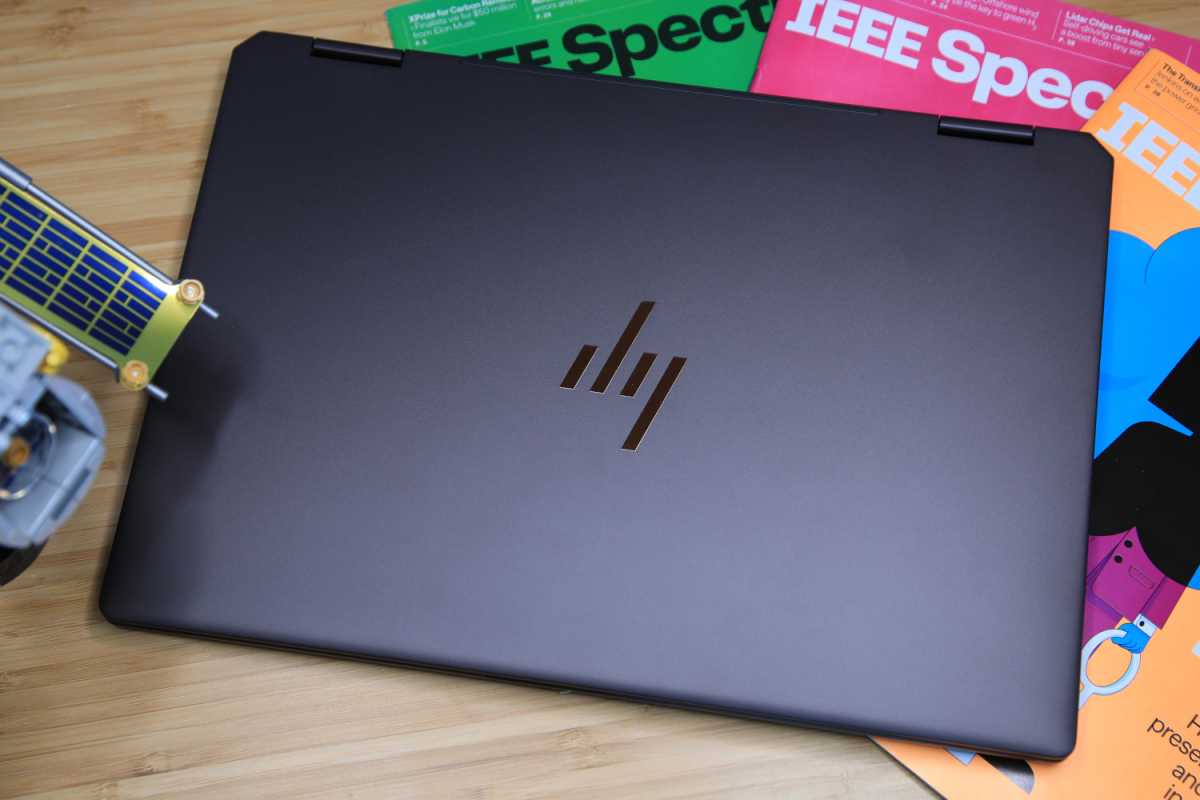
IDG / Matthew Smith
IDG / Matthew Smith
IDG / Matthew Smith
I was immediately smitten by the HP Spectre x360 14. Not because it’s different, or innovative, but because HP bothers to get the boring things right.
That begins with the quality of the materials used. The Spectre x360 14 uses metal for the upper and lower body, as well as the hinges. That’s not unusual for a 2-in-1 above $1,000, but the specific texture and luster HP picked stands out. It appears sleek and modern but, when handled, has just enough grip and texture to feel pleasant and inviting. The chassis isn’t unibody, meaning it has a removable bottom panel, but it feels nearly as rigid as 2-in-1s that go that route.
The design also benefits from attention to detail. The Spectre x360 has a stern, professional look, but the edges of the device are smoothed to keep them from pressing into your palms and fingers. That’s important for a device meant to be used like a tablet. The 360-hinge design also works flawlessly. It offers enough tension to keep the display at a desired angle, yet remains smooth when folding the device from laptop to tablet mode, or vice-versa.
That’s not to say it’s perfect, and the usual compromises are required. As its name implies, the Spectre x360 14 has a 14-inch display, so it’s much larger than even the largest iPad Pro. It also weighs 3.19 pounds, which is a lot of heft to maneuver with your fingertips. The Spectre x360 is usable as a tablet for short periods of time, or when resting in your lap or knees, but it’s not great if you want a tablet for note-taking, to read books or documents, or to use while reclining.
HP faces stiff competition from alternatives like the Lenovo Yoga 9i 14, which also delivers thin, light, and attractive design. I think HP remains a step behind Lenovo but, of course, that’s subject to taste. The Lenovo Yoga 9i strikes a more luxurious and elegant profile, while the Spectre x360 14 is more professional and serious. And while the HP doesn’t beat the Lenovo, it’s an obvious upgrade over more affordable 2-in-1s like the Asus Zenbook 14 Flip OLED.
HP Spectre x360 14: Keyboard, trackpad
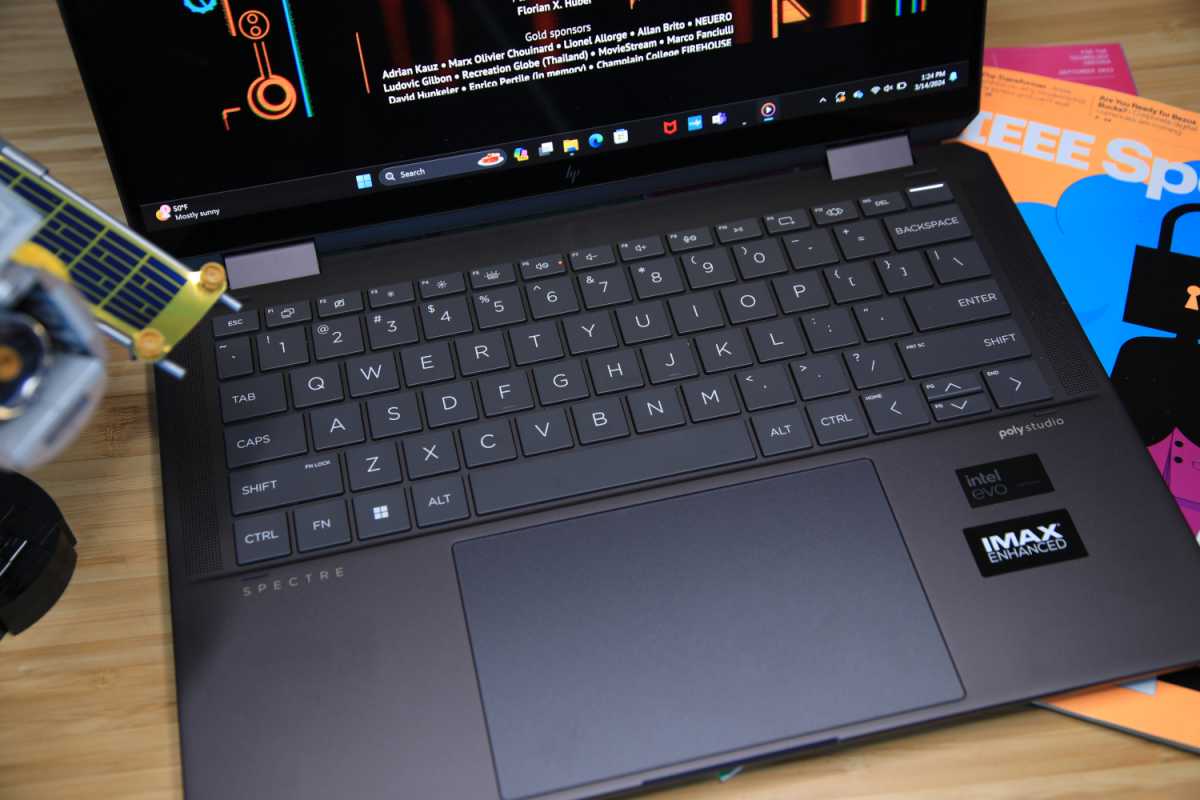
IDG / Matthew Smith
IDG / Matthew Smith
IDG / Matthew Smith
I expect, however, that the Spectre x360 14 will be used as a laptop far more often than a tablet. Fortunately, HP’s excellent design extends to the keyboard and touchpad.
The keyboard occupies a significant portion of the 2-in-1’s width, though it does sacrifice a few millimeters to upwards-firing speakers on each side. Despite that, the keyboard has a spacious layout and most keys are large. The left-side Shift, Caps, and Tab keys are shaved down a bit, but not so much I found it noticeable. There’s also plenty of space below the keyboard, so my palms weren’t left dangling in mid-air.
Key travel is respectable despite the slim profile and each key ends its action with a definitive tactile action. However, I think HP missed the mark on the plastic used for the key caps. It feels thin and takes away from the otherwise luxurious design. That’s a shame, since the keyboard is the part of the device most often touched.
The touchpad is another highlight. It’s large for a 14-inch laptop at five and a half inches wide by three and a quarter inches deep. There’s barely any space leftover to extend its depth and making it any wider would’ve left my palms sitting wholly inside the touchpad surface, which can lead to unwanted mouse clicks. The touchpad is responsive and its size provides ample room for activating Windows’ most complex multi-touch gestures.
HP Spectre x360 14: Display, audio
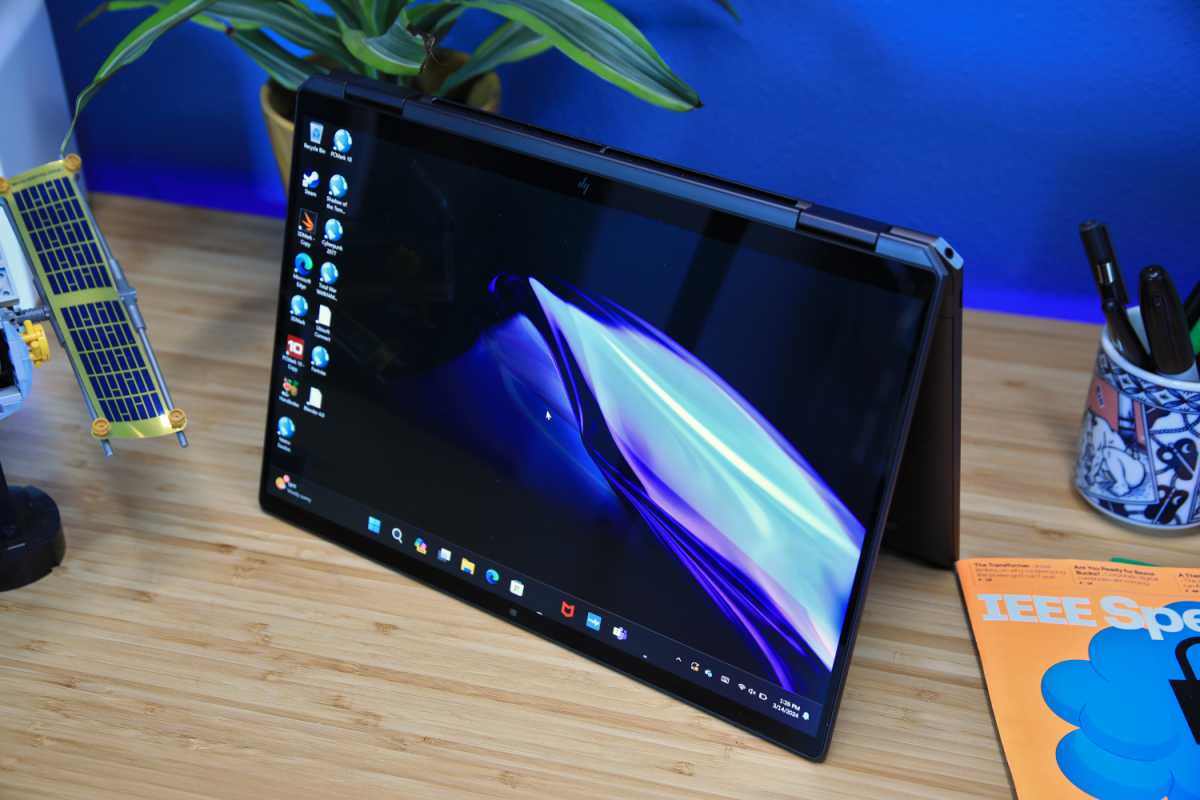
IDG / Matthew Smith
IDG / Matthew Smith
IDG / Matthew Smith
Every 2024 HP Spectre x360 14-inch has a 2880×1800 OLED touchscreen with a maximum refresh rate of 120Hz. It’s a beautiful display with rich colors, incredible contrast, good motion clarity, and crisp sharpness.
The downside is brightness, which isn’t as high as some IPS displays and, in combination with the glossy display finish, can at times make the display hard to use in a bright room (or outdoors). But that’s soon forgiven when watching a show on Netflix, playing a PC game, or editing a photo. Media always looks fantastic.
It’s also a touchscreen, and the particulars of HP’s design make it easy to use. The 2-in-1 is small enough that the screen remains within easy reach while typing, and the 360 hinge allows for “tent mode,” which rotates the keyboard behind the display and effectively makes it a kickstand. The included active stylus is a nice bonus, too, and makes for quick, easy note-taking. The stylus is thick—more like a marker than a pen, really. I find this comfortable, but people with smaller hands might disagree.
While the OLED touchscreen is fantastic, it’s also shared with many competitors. Many laptops now offer this exact display panel, which is produced by Samsung, with and without a touchscreen. And some competitors, like the Asus Zenbook 14 Flip OLED, are much less expensive.
The Spectre x360 14’s impressive visuals are matched with strong audio from the upwards-facing speakers. They’re clear, crisp, and loud at maximum volume, but only become muddy in the most bass-heavy music and action sequences. Lenovo’s Yoga 9i has HP beat here, but that competitor ranks among the best audio available on Windows 2-in-1. The Spectre’s speakers are well above average.
HP Spectre x360 14: Webcam, microphone, biometrics
The HP Spectre x360 14’s webcam goes above and beyond with full 4K resolution at up to 30 frames per second. That’s a very high resolution for a laptop or 2-in-1 webcam and it predictably results in a sharp, attractive image. Exposure is handled well, too, and colors look saturated. In short, it’s a superb webcam.
The dual microphone array is run-of-the-mill but does the job. My voice came through clearly even when I spoke softly and the most obvious, repetitive background noise was rejected. The microphone can sound tinny, hollow, or distant, so I wouldn’t recommend it for podcasting or other more demanding audio recording needs, but it’s great for Zoom.
Windows Hello biometric login is supported through a fingerprint reader on the power button, which is located on the keyboard, and facial recognition through the included IR camera. I always prefer facial recognition when it’s available, as it’s quicker and more reliable than any fingerprint reader I’ve encountered. Still, it’s nice to have options. Many competitive laptops have either an IR camera or a fingerprint reader, but few have both.
HP Spectre x360 14: Connectivity
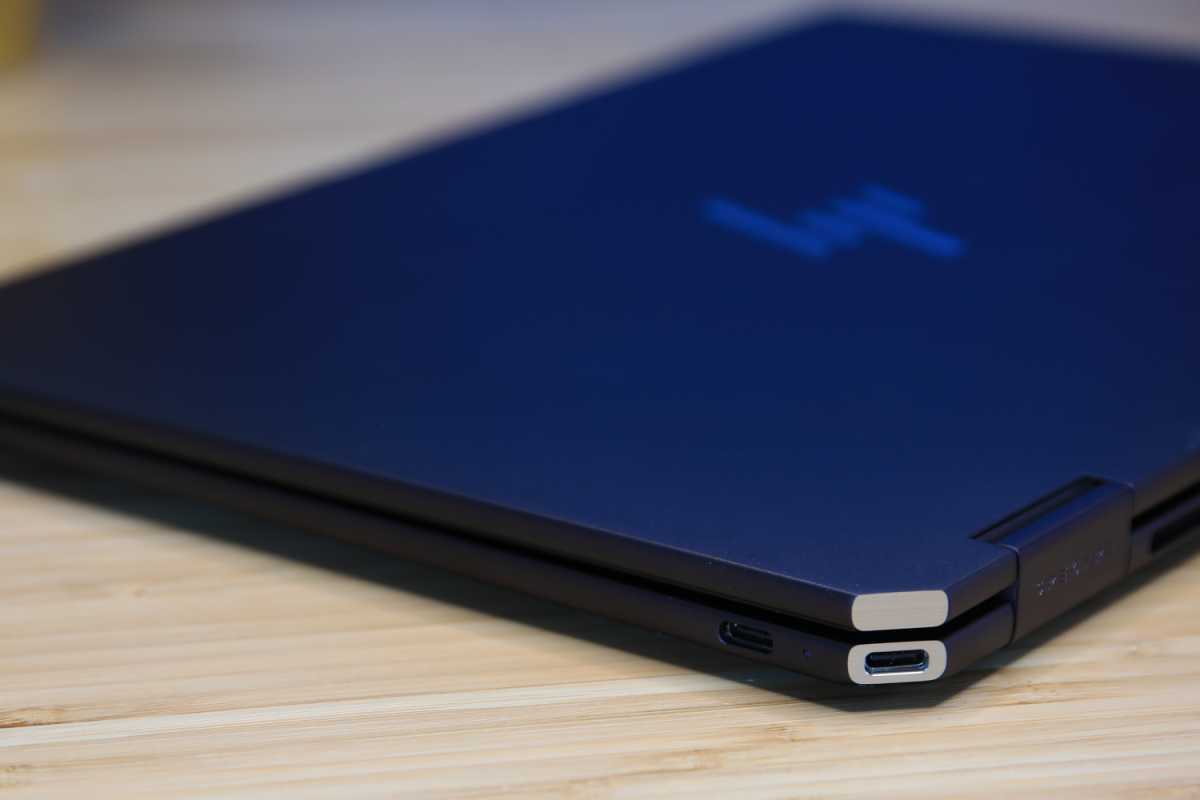
IDG / Matthew Smith
IDG / Matthew Smith
IDG / Matthew Smith
Thin design often leads to a thin selection of ports, and the HP Spectre x360 14 suffers this fate. It has just two USB-C ports, both with DisplayPort and Power Delivery, and one USB-A port. There’s also a 3.5mm combo audio jack. It is good to see that USB-A is at least available, but the combined lack of Ethernet, HDMI, and an SD card reader really narrows the options. I think most owners will need to invest in a USB-C hub or dock.
While the port selection is mediocre, HP does have a trick up its sleeve. The 3.5mm combo audio jack and one USB-C port are placed on the far left and right rear corner of the 2-in-1, respectively, and the corner sits at an angle. That makes the ports easy to access from both the rear and side of the 2-in-1 and makes it less likely that the ports will get in the way of your hands when using the Spectre x360 14 as a tablet. It’s an uncommon choice, but a smart one.
The 2-in-1’s wired connectivity is joined by standard Wi-Fi 6E and Bluetooth 5.3. An optional Wi-Fi 7 upgrade, which also includes Bluetooth 5.4, is available (though the model I tested didn’t include it). I think Wi-Fi 7 should be standard, but its absence is a minor point, as few people yet own a Wi-Fi 7 router.
HP Spectre x360 14: Performance
The entry-level HP Spectre x360 14 ships with an Intel Core Ultra 5 125H processor, but the model I tested had the upgrade to Intel’s Core Ultra 7 155H. It also had 32GB of soldered LPDDR5 memory and a 2TB PCIe NVMe M.2 solid state drive. It delivered solid performance, though the 2-in-1’s thermal and power limits can limit its potential.
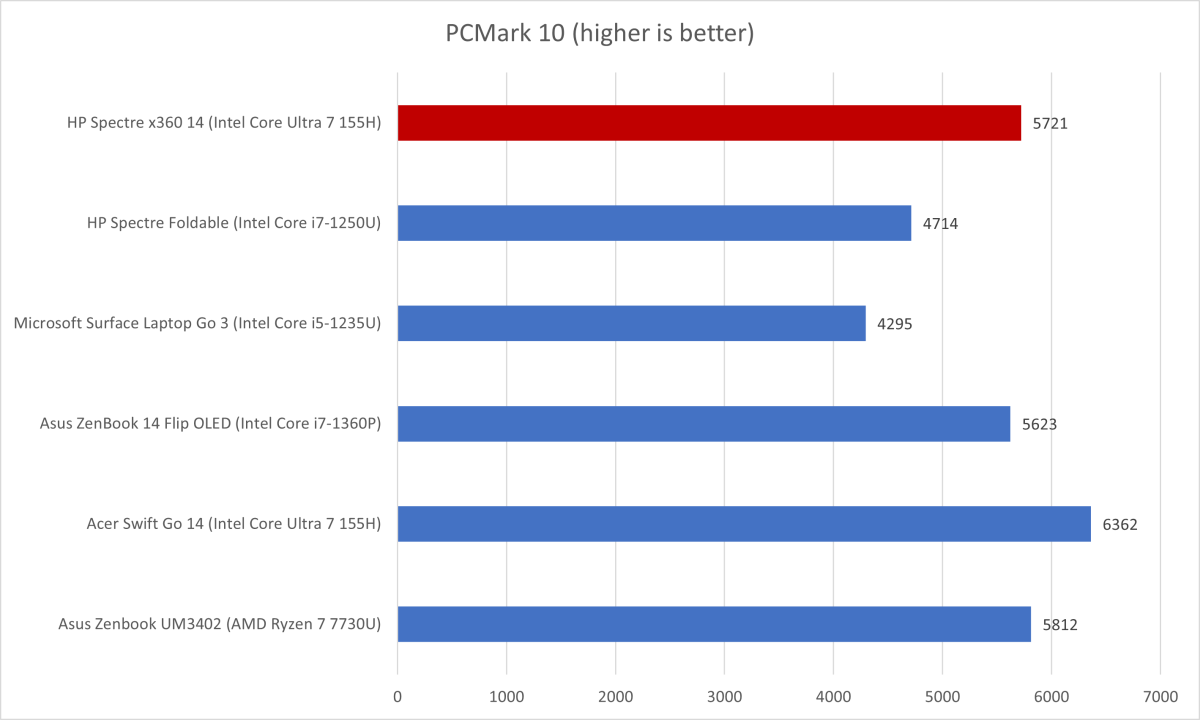
IDG / Matthew Smith
IDG / Matthew Smith
IDG / Matthew Smith
We start off with PCMark 10, where the HP Spectre x360 delivers a strong score of 5,721. That’s better than many older, similar devices, and it defeats last year’s Intel Core i7-1360P, which found its way into many Windows 2-in-1s.
However, the Spectre x360 14 lands just a smidge behind the Asus Zenbook UM3402 with AMD Ryzen 7 7730U, and significantly behind the Acer Swift Go 14 with Intel Core Ultra 7 155H. The Swift Go 14 is a thicker, less expensive laptop.
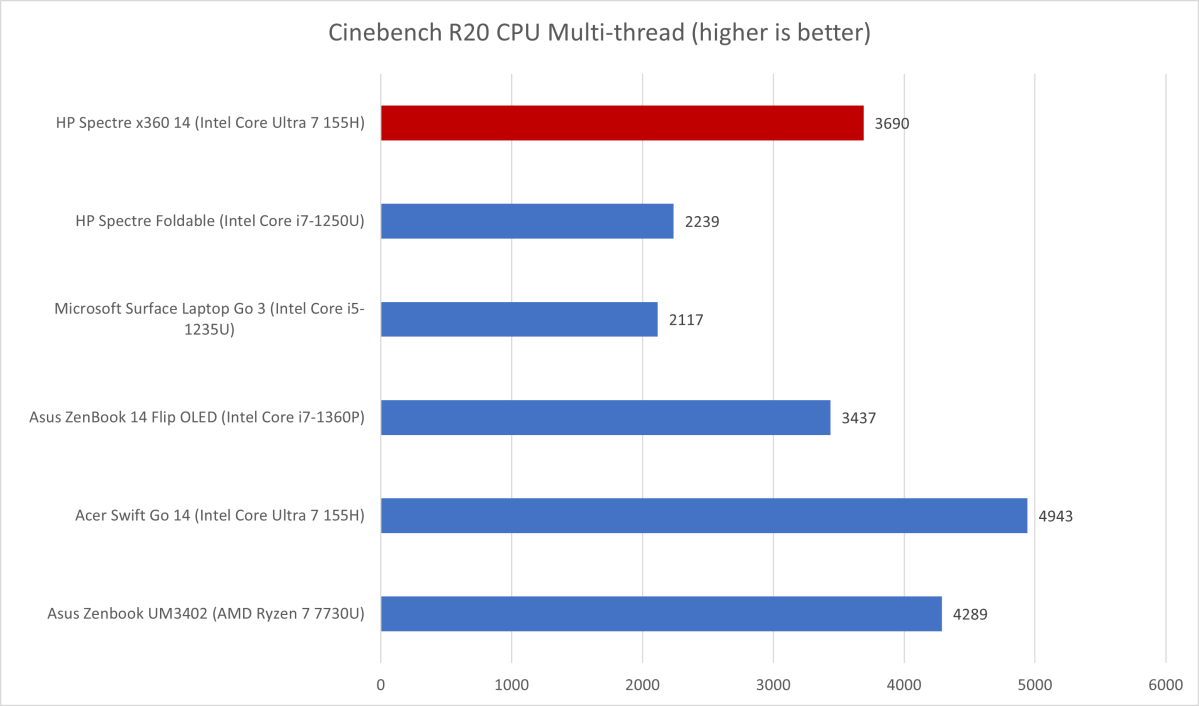
IDG / Matthew Smith
IDG / Matthew Smith
IDG / Matthew Smith
Next up is Cinebench R20, a heavily multi-threaded, short-duration processor benchmark. Here the HP Spectre x360 14 again performs much better than older 2-in-1 devices, but it can’t keep up with thicker mid-range laptops like the Asus Zenbook UM3402 and Acer Swift Go 14.
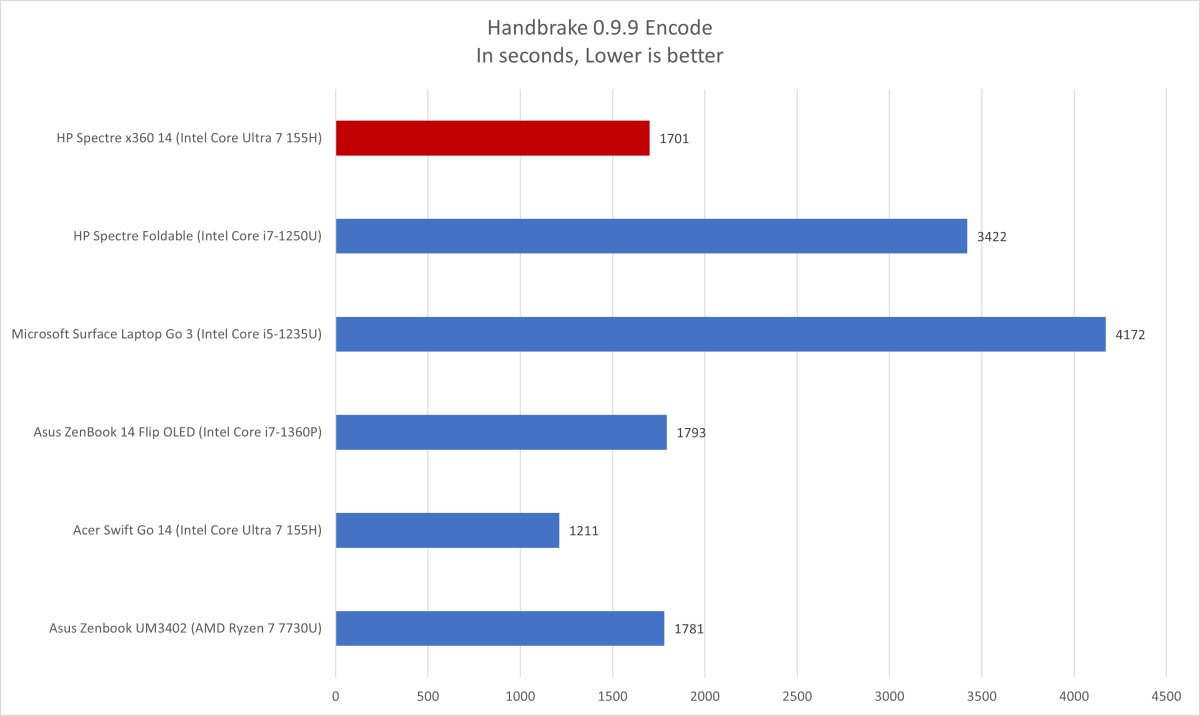
IDG / Matthew Smith
IDG / Matthew Smith
IDG / Matthew Smith
Handbrake, a long-duration processor benchmark, (mostly) tells a similar story. Here the HP Spectre x360 14 does beat the AMD-powered Asus Zenbook UM3402, but it’s way behind the Acer Swift Go 14, despite the fact they both have an Intel Core Ultra 7 155H processor.
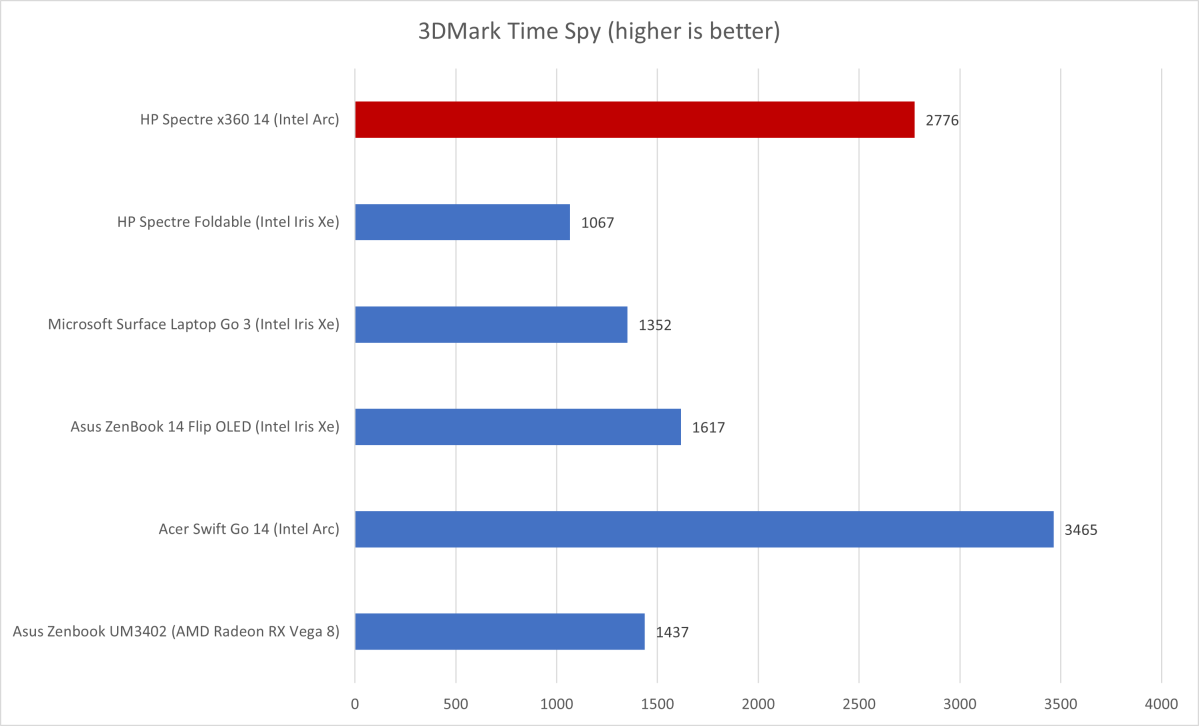
IDG / Matthew Smith
IDG / Matthew Smith
IDG / Matthew Smith
The Intel Core Ultra 7155H includes Intel Arc graphics with eight Xe Cores. It delivers a massive upgrade over the Intel Xe integrated graphics found in prior Intel Core processors. The Asus Zenbook 14 Flip OLED only scored 1,617 in this test, while the HP Spectre x360 14 scores 2,776.
Intel Arc integrated graphics still has limits, of course, and will generally lag far behind entry-level consumer graphics, such as Nvidia’s RTX 4050. Still, this is a meaningful boost that should make it possible to play many older 3D games ported to the PC from the PlayStation 4 and Xbox One.
All the performance results reported above were obtained in the Spectre x360 14’s default “Smart Sense” power profile, which is meant to balance performance and thermals. But HP also provides a “Performance” profile for enhanced performance, and it delivers the goods. The 2-in-1’s Cinebench R20 score increased from 3,690 to 5,412; 3DMark Time Spy increased from 2,776 to 3,735. That’s a huge gain that more than makes up the gap between the HP Spectre x360 14 and the Acer Swift Go 14. Despite this increase, the Performance mode is not irritating. Fan noise is increased, and the 2-in-1 becomes hot, but I’ve reviewed plenty of laptops that were louder and hotter in their default performance mode.
Given this result, I think HP should tweak the “Smart Sense” to more aggressively push performance in apps that require it. I believe many owners will never change this setting, or may change it back and forth only occasionally. Unfortunately, forgetting to use the right performance mode for the job leaves a lot of performance off the table.
Still, the performance is there if you know where to look, and it’s impressive for a 2-in-1 of this size. The HP Spectre x360 14 has its limits, but it’s capable of work well beyond web-browsing and document editing. 1080p video editing, digital art, and older 3D games are all well within reach.
HP Spectre x360 14: Battery life
The HP Spectre x360 14 ships with a 68 watt-hour battery. That’s a healthy capacity for a 14-inch 2-in-1, but modern processors can prove rather power-hungry. These conflicting forces balance each other out.
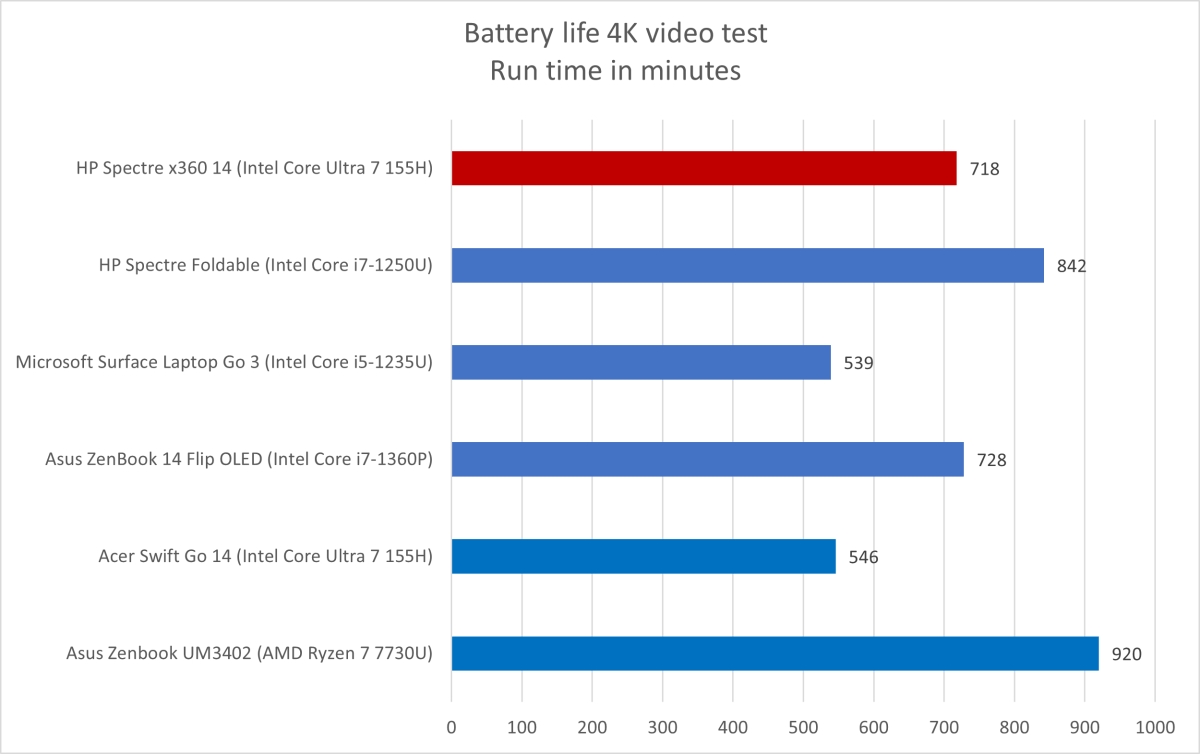
IDG / Matthew Smith
IDG / Matthew Smith
IDG / Matthew Smith
I recorded over 11 hours of battery life in our standard battery test, which loops a 4K trailer of the short film Tears of Steel. That’s an unexceptional but sold result for a modern 2-in-1 and, importantly, it should be enough to provide most users a full workday away from a charger—so long as the most demanding applications are avoided, at least.
The Spectre also benefits from USB Power Delivery and relatively low power draw. The included charger is small, and most third-party USB-C chargers intended for laptops will have plenty of juice to charge this 2-in-1. That improves portability, as there’s no need to pack a charger specific to the 2-in-1.
HP Spectre x360 14: Conclusion
HP’s Spectre x360 14 is a great option if you want a 14-inch Windows 2-in-1 and plan to make full use of its 2-in-1 versatility. It’s thin, light, portable, well-built, and ships with a standard touchscreen and active stylus. The Spectre x360 also benefits from a beautiful OLED display, strong performance, and a large touchpad, and a top-tier webcam. It’s not inexpensive and has a few downsides, like limited connectivity and a merely good keyboard, but it’s on-target for shoppers who still want to live the Windows 2-in-1 dream.
Best Prices Today: HP Spectre x360
RetailerPrice
Author: Matthew S. Smith
Matthew S. Smith is a freelance technology journalist with 15 years of experience reviewing consumer electronics. In addition to PCWorld, his work can be found on Wired, Ars Technica, Digital Trends, Reviewed, IGN, and Lifewire. Matthew also covers AI and the metaverse for IEEE Spectrum and runs Computer Gaming Yesterday, a YouTube channel devoted to PC gaming history.
Recent stories by Matthew S. Smith:
Acer Predator Helios Neo 18 review: A huge gaming laptop for a small priceAcer Chromebook 516 GE review: A cloud gaming powerhouseAsus Zenbook 14 OLED review: A budget laptop star



